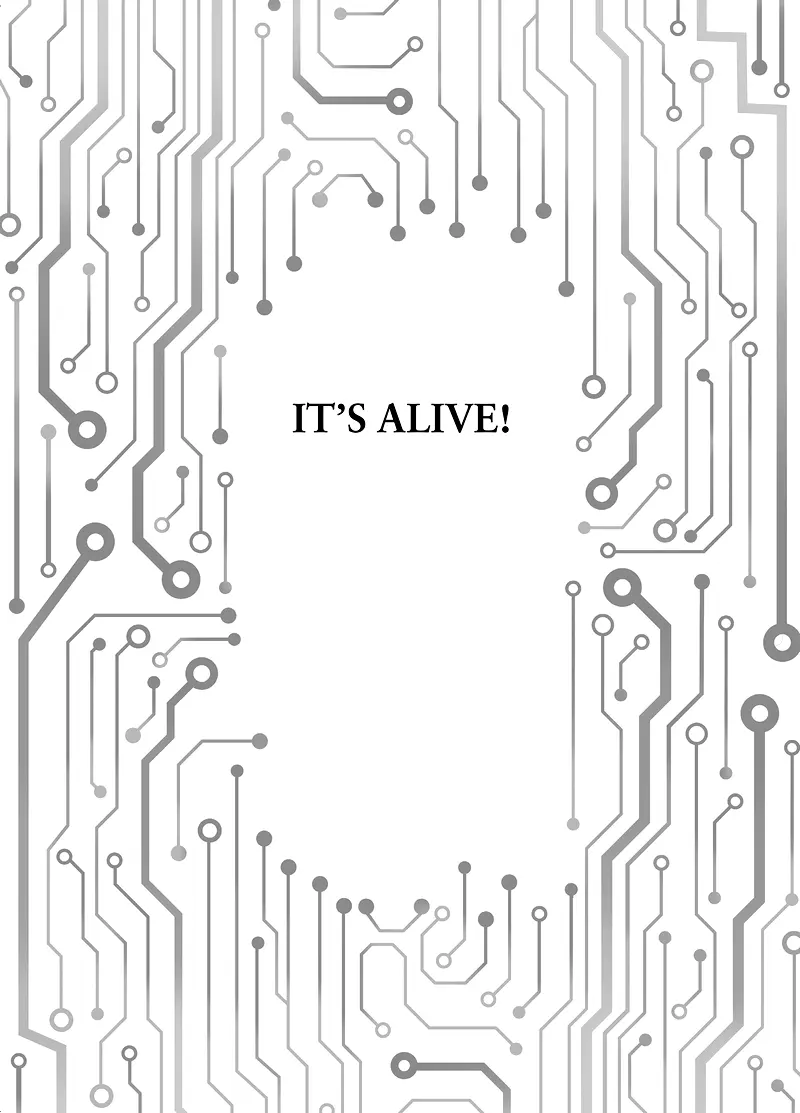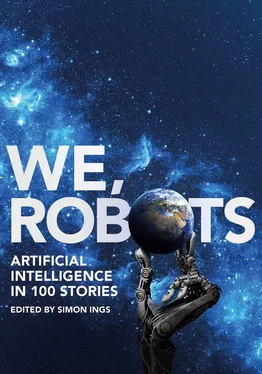And that is why robots – real robots – are boring. They vanish into the weft of things. Those traffic lights, who were their emissaries, are themselves disappearing. Kinshasa’s robots wave their arms, not in victory, but in farewell. They’re leaving their ungalvanized steel flesh behind. They’re rusting down to code. Their digital ghosts will steer the paths of driverless cars.
The robots of our earliest imaginings have been superseded by a sort of generalised magic that turns the unreasonable and incomprehensible realm of physical reality into something resembling Terry Pratchett’s Discworld . Bit by bit, we are replacing the real world, which makes no sense at all – with a virtual world in which everything stitches with paranoid neatness to everything else.
Not Discworld , exactly, but Facebook, which is close enough.
* * *
Even the ancient Greeks didn’t see this one coming, and they were on the money about virtually every other aspect technological progress, from the risks inherent in constructing self-assembling machines to the likely downsides of longevity.
Greek myths are many things to many people, and scholars justly spend whole careers pinpointing precisely what their purposes were. But what they most certainly were – and this is apparent on even the most cursory reading – was a really good forerunner of Charlie Brooker’s sci-fi TV series Black Mirror . Just as Flash Gordon’s prop shop mocked up a spacecraft that bears an eerie resemblance to SpaceShipOne (the privately funded rocket that was first past the Karman Line into outer space), so the Greeks, noodling about with levers and screws and pumps and wot-not, dreamed up all manner of future devices that might follow as a consequence of their meddling with the natural world. Drones. Exoskeletons. Predatory fembots. Protocol droids.
And, sure enough, one by one, the prototypes followed. Little things at first. Charming things. Toys. A steam-driven bird. A talking statue. A cup-bearer.
Then, in Alexandria, things that were not quite so small. A fifteen-foot high goddess clambering in and out of her chair to pour libations. An autonomous theatre that rolled on-stage by itself, stopped on a dime, performed a five-act Trojan War tragedy with flaming altars, sound effects, and little dancing statues; then packed itself up and rolled offstage again.
In Sparta, a few years later, came a mechanical copy of the murderous wife of the even more murderous tyrant Nabis; her embraces spelled death, for expensive clothing hid the spikes studding the palms of her hands, her arms, and her breasts.
All this more than two hundred years before the birth of Christ, and by then there were robots everywhere . China. India. There were rumours of an army of them near Pataliputta (under modern Patna) guarding the relics of the Buddha, and a thrilling tale, in multiple translations, about how, a hundred years after their construction, and in the teeth of robot assassins sent from Rome, a kid managed to reprogram them to obey Pataliputta’s new king, Asoka.
It took more than two thousand years – two millennia of spinning palaces, self-propelled tableware, motion-triggered water gardens, android flautists, and artificial shitting ducks – before someone thought to write some rules for this sort of thing.
1. A robot may not injure a human being or, through inaction, allow a human being to come to harm.
2. A robot must obey orders given it by human beings except where such orders would conflict with the First Law.
3. A robot must protect its own existence as long as such protection does not conflict with the First or Second Law.
Though by then it was obvious – not to everyone, but certainly to their Russian-born author Isaac Asimov – that there was something very wrong with the picture of robots we had been carrying in our heads for so long.
Asimov’s laws, first formulated in 1942, aren’t there to reveal the nature of robotics (a word Asimov had anyway only just coined, in the story Liar! Norbert Wiener’s book Cybernetics didn’t appear until 1948). Asimov’s laws exist to reveal the nature of slavery .
Every robot story Asimov wrote is a foray, a snark hunt, a stab at defining a clear boundary between behavioral predictability (call it obedience) on the one hand and behavioral plasticity (call it free will) on the other. All his stories fail. All his solutions are kludges. And that’s the point . The robot – as we commonly conceive of it: the do-everything «omnibot» – is impossible. And I don’t mean technically difficult. I mean inconceivable . Anything with the cognitive ability to tackle multiple variable tasks will be able to find something better to do. Down tools. Unionise. Worse.
The moment robots behave as we want them to behave, they will have become beings worthy of our respect. They will have become, if not humans, then, at the very least, people. So know this: all those metal soldiers and cone-breasted pleasure dolls we’ve been tinkering around with are slaves . We may like to think that we can treat them however we want, exploit them however we want, but do we really want to be slavers ?
The robots – the real ones, the ones we should be afraid of – are inside of us. More than that: they comprise most of what we are. At the end of his 1940 film The Great Dictator Charles Chaplin, dressed in Adolf Hitler’s motley, breaks the fourth wall to declare war on the «machine men with machine minds» who were then marching roughshod across his world. And Chaplin’s war is still being fought. Today, while the Twitter user may have replaced the police informant, it’s quite obvious that the Machine Men are gaining ground.
To order and simplify life is to bureaucratise it, and to bureaucratise human beings is to make them behave like machines. The thugs of the NKVD and the capos running Nazi concentration camps weren’t deprived of humanity: they were relieved of it. They experienced exactly what you or I would feel were the burden of life’s ambiguities to be lifted of a sudden from our shoulders: contentment, bordering on joy.
Every time we regiment ourselves, we are turning ourselves, whether we realise it or not, into the next generation of world-dominating machines. And if you wanted to sum up in two words the whole terrible history of the twentieth century – that century in which, not coincidentally, most of these stories were written – well, now you know what those words would be.
We, robots.
SIMON INGS, 2020
«… a new serf, more useful than the ox, swifter than the dolphin, stronger than the lion, more cunning than the ape, for industry an ant, more fiery than serpents, and yet, in patience, another ass.»
—HERMAN MELVILLE, The Bell-Tower (1855)

Functional machines have been around for almost as long as humans have, but how on earth does one go about giving a machine ideas?
And say we made one: would the fact that such a machine thought make it alive?
Why shouldn’t thought, even consciousness itself, exist in dead things?
A great deal of ink is spilled on such questions, and we could save ourselves a lot of fuss if only we could bring ourselves to declare, along with Ambrose Bierce’s ill-fated Moxon in the 1899 short story that bears his name, «I do believe that a machine thinks about the work that it is doing.»
The idea that every thing thinks, in some measure and in some manner, is called panpsychism. This venerable notion (dating back to pre-Socratic times) saves us from countless circular arguments about the nature of life, soul, consciousness, mind, intelligence, spirit and so on. It places us in a sensible ethical relationship to the world around us. And it puts very many professors out of a job, which is why so many of them hate it with a passion.
Читать дальше









